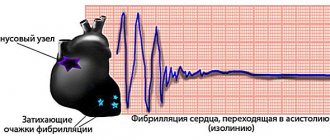At one of the facilities where I was doing repairs, several electrical components burned out, so I had to change all the wiring. My apprentice decided to take the initiative and, without supervision, climbed into the shield without safety precautions. Yes, he was electrocuted and had to be pulled back, but he remained alive and well. When he asked why he did this, he said that he thought that he was not grounded, because he was standing on the floor, and the voltage was not lethal. For those like him who know nothing about safe voltage, I’ll tell you more about it.
Source yato-tools.ru
According to experienced electricians, the main danger of electric current is that it is invisible. At the same time, electricity itself, which affects the human body, can cause serious consequences, even death. In short, it has been established that a current of 50-100 mA passing through the human body is life-threatening, and more than 100 mA is fatal. In addition, there is a difference with what it hits - next we’ll look at why alternating current is more dangerous than direct current.
Source prom.st
The principle of current influence
And first of all, you need to consider how currents dangerous to humans affect him. If we compare it with other dangerous phenomena, the main difference will be the fact that it has no color or smell. Any current is virtually invisible to a person and this does not mean at all that its contact with the body is safe. The main types of impact are:
- Thermal. It is expressed in burns throughout the body, as well as intense heating of blood vessels and nerve endings.
- Electrolytic. This exposure causes the decomposition of blood and other fluids in the body. It occurs through electrolysis, which also affects the physicochemical component of the fluid in the body. To put it simply, the blood thickens, the charge of proteins changes and vaporization begins in the body.
- Biological. The cause of all convulsions and contractions, since the action of electric current is naturally accompanied by irritation of all organs.
Now that we have the basics, we can move on to quantities that are dangerous to human life.
Dangerous voltage
First of all, we note that it is a mistake to think about the presence of dangerous and non-hazardous electric current - any impact is negative, only the degree of harm differs. The reason why one person will suffer less and another will suffer more is due to internal resistance. It also depends on the thickness of the skin, the humidity level of the room in which the contact occurred, and the human body, as well as the path of the current.
And this needs to be given special attention, because the most dangerous current flow for human life is either through the leg and head, or through the arm and head. This is because the current passes through the heart, brain and lungs. And if the DC or AC voltage is high, then in worst cases it causes cardiac or respiratory arrest.
It has been established that direct current is slightly safer for humans than alternating current if everything happens within networks up to 500 V. And as soon as the voltage begins to rise, the danger to humans grows along with it.
However, this is not all, because it is also important to consider the network frequency. If we take 500 Hz for consideration, then it is somewhat safer than industrial 50 Hz. This is due to the fact that with increasing frequency, the Skin Effect gradually appears, the essence of which is the passage of current along the surface of the conductor, due to which the internal organs are not affected.
The final value of the danger of current for a person is time. If you are exposed to direct or alternating current for a long time, the damage will be higher than a short-term shock. And, although here you also need to take into account the strength of the current in order to give a definite answer, the less time under influence, the better.
What role does body resistance play?
The body's resistance depends on the condition of its skin; it can be influenced by the following factors:
- In what condition, for example, can human skin be clean, dirty, wet, damaged?
- What was the area of contact of the current with the skin?
- The magnitude of the applied voltage.
- What frequency current passed through the body.
- General condition of the human nervous system.
If the skin is scratched or scratched, dangerous stress may be minimal until death as the body's resistance is reduced. A person with a sweaty or dirty hand loses the ability to resist. For example, a voltage of 30 volts on dry hands does not cause severe pain, but if you touch it with a wet hand, a person will not be able to unclench his fingers and will experience severe pain. In such cases, it is customary to talk about a violation of skin resistance.
Skin resistance can decrease even when low voltage is applied, this is 20-40 volts.
Additional impacts
Among other things, it is also necessary to take into account other effects that direct and alternating current creates when passing through the human body. These include:
- Electric shock. It provokes stimulation of all tissues, which leads to convulsions and their consequences. These may include loss of consciousness, respiratory or cardiac dysfunction, and death.
- Electrical injury. This is damage that is caused directly to the body. There are two types of them:
- Electrical burn. It is divided into current, which represents the passage of current through the entire body, and also arc, the appearance of which occurs between the conductor and a person. It can be clearly identified by the arc that appears upon contact. And it is also several times more dangerous than current, since its temperature can be several times higher.
- Metallization of leather. A phenomenon that means when metal particles enter the skin. The consequence of this is increased conductivity and greater risk of injury.
It is also worth remembering about electrical marks, which represent the places where the current entered and where it came out from.
Which current is more dangerous: direct or alternating current?
When the basics are sorted out, you need to determine which current is more dangerous to life, direct or alternating. The answer to this question is simple - alternating current is more dangerous than direct current. And that's why:
- the same effect of both types of current can only occur when the DC power exceeds the AC power by 4 times;
- the cause of death is ventricular fibrillation, the risk of which is much higher when the body is exposed to alternating current;
- There is a rule: if the frequency is lower, then the resistance is higher, but for a variable, the minimum frequency value of which almost always reaches 50 Hz, the resistance is low.
Such an impact can be avoided not only by using safety precautions, but also by observing the rules for electrical installations.
Validity of danger
Previously, we briefly touched on why direct and alternating current are dangerous for humans. It's time to look at all the factors in more detail. There are four factors:
- Current and voltage. Current is measured in milliamps (mA). So, for an alternating voltage, a value from 10 to 15 mA is enough under a “standard” voltage of 120 V, and for a constant voltage of about 50-80 with a voltage of U = 42 V to cause harm to a person. However, you should not think that constant therefore becomes safer, because at the same 500 V both become equal in damage caused.
- Duration. It is obvious to everyone that the longer one is under electric shock, the worse it gets. However, not everyone knows why this is so. Being exposed to current for a long time destroys the epidermis and, as a result, reduces the resistance of the body, which automatically “increases” the current strength.
- Frequency. it represents the value of the fluctuations of the poles of the network, which in the CIS countries reaches 50 Hz. However, this unit of measurement has nothing to do with direct current, since in its case the electrons move in one direction. The Skin Effect already discussed is achieved at a frequency above 20 kHz, and this was experimentally proven by Nikola Tesla.
- Resistance. Understanding how it works doesn't require any special knowledge. It is only worth remembering that an increase in resistance is associated with a lower current strength, and vice versa. If there are dry and rough areas of skin on the body, then they can act as a dielectric, which will set the body resistance value from 40,000 to 100,000 Ohms.
- high body temperature;
- damaged epidermis;
- high ambient humidity.
Sweating also reduces the body's resistance because it introduces moisture and increased temperature.
Now we not only know which values are unsafe for humans, but also why this is so.
Interesting facts about electricity
- In order to extract electricity from a magnet from a speaker, two copper wires are wound around it, their two ends are soldered together, and a small light bulb or LED strip is connected to the remaining ones. In order to make a power source for a 220 V incandescent lamp, more powerful and larger magnets and thick copper wires of large cross-section are used.
- The oldest battery is considered to be a device found during excavations in Egypt, which is a copper vessel with an iron rod inserted into it that does not touch the walls.
- In order to show how electricity is generated and flows, at the court of King Louis XV they conducted an experiment with a Leyden jar and a formation of soldiers: the soldiers holding hands formed nothing less than the world's first full-fledged living electrical circuit;
- Due to the large number of deaths from lightning in Italy in the 18th century, a very strange fashion for hats and umbrellas with lightning rods appeared in many European countries;
- In Scandinavian countries, the main, and sometimes the only, source of electricity is hydroelectric power plants. Thanks to this, these countries have very low levels of air pollution.
Knowing how familiar electricity works is very important for every person, not only for the purpose of self-education and broadening one’s horizons, but also to ensure one’s own safety in a world where quite dangerous electricity is found at almost every step.
Consequences of electric shock
And although any dangerous current will be dangerous for a person in most cases, the consequences of its exposure have a number of differences. It depends on the body system that suffered the main damage:
- Nervous. In this case, there may be loss of consciousness or memory, in special cases permanently. If the nerves are affected, then sensitivity or motor activity as such may be impaired. There are also precedents when pathological reflexes appear and physiological ones gradually disappear. In cases of exposure to high voltage, a disorder of the central nervous system occurs and further inhibition of all centers responsible for respiratory and cardiac activity occurs.
- Cardiovascular. Here the basis is functional harm, which is sinus arrhythmia and tachycardia, as well as blockades and extrasystole. Internal bleeding is also possible due to damage to the walls of blood vessels.
- Sense organs. This is mainly tinnitus or decreased sensitivity of the limbs. There may also be ruptured eardrums and deafness. If the eyes are damaged, there is a risk of keratitis, choroiditis and cataracts.
- Long term harm. An electric shock does not always go away without a trace, even after eliminating the damage that occurred immediately. So, a person may subsequently develop neuritis or trophic ulcers. Within the cardiovascular system, disturbances in the conduction of impulses occur. Burns caused by an electric shock heal, but in rare cases they develop deformation of the musculoskeletal system. Subsequent exposure to current can provoke arteriosclerosis or autonomic changes.
The danger is also that it is not always possible to completely cure a person after this. In special cases, it is difficult to even level out the passive pain that a person experiences.
Avoiding harm from electric shock is much easier than it might seem. Using devices that comply with the Eligibility Regulations, and also not touching electrical devices with wet hands - basic safety requirements - will significantly reduce the likelihood of an impact.
Causes of defeat
First of all, the cause of increased electrical injuries is inattention and carelessness, as well as ignorance of electrical safety rules and the operation of electrical appliances
Important! The opinion that you can get an electric shock just by touching an open, obvious live part is very erroneous. In high-voltage electrical installations, it is enough to approach them at a certain distance (for electrical installations up to 1000V it is not regulated, but without touching, over 1000V at least 60 cm) to get under voltage
Safe distance from downed power line
To avoid electric shock or personal injury, do not:
- Climb onto power line supports;
- Approach less than 10 m to broken wires: hanging or lying on the ground;
- Make any unauthorized connections and switching, even in household electrical panels;
- Throw foreign objects onto the wires, touch the wires with poles, etc.;
- Set up landfills, start fires near the security zone of power lines (for 0.4 kV overhead lines - 2 meters, for 6(10) kV overhead lines - 10 meters);
- Enter transformer substations, open switchgears, open their doors, approach live parts.
In domestic conditions you cannot:
- Touch exposed wires connected to the electrical network;
- Connect any electrical appliance to the network with wet hands;
- Retrieve an electrical device connected to the network that has fallen into the water with bare hands.
Moisture and electrical appliance
Current conductors are: metals, earth, water, any living creature.
The following do not conduct current: dry wood, rubber, plastic, concrete (but not reinforced concrete), plaster, glass, synthetics.











